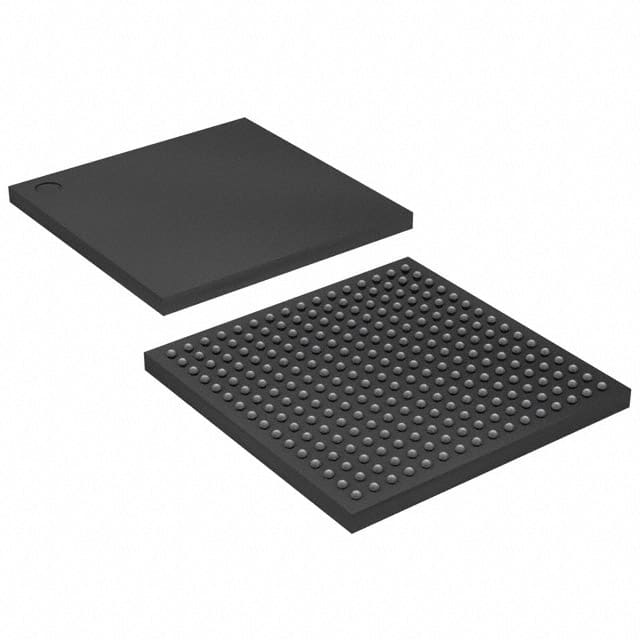EP2C8F256C8
Product Overview
- Category: Integrated Circuit (IC)
- Use: Programmable Logic Device (PLD)
- Characteristics: High-performance, low-power consumption
- Package: 256-ball FineLine BGA package
- Essence: Field-Programmable Gate Array (FPGA)
- Packaging/Quantity: Single unit
Specifications
- Logic Elements: 8,000
- Embedded Memory: 256 Kbits
- Maximum User I/Os: 202
- Clock Management: Phase-Locked Loops (PLLs)
- Operating Voltage: 1.2V
- Speed Grade: -8
- Temperature Range: Commercial (0°C to 85°C)
Detailed Pin Configuration
The EP2C8F256C8 has a total of 256 pins. The pin configuration is as follows:
- Pin 1: VCCIO
- Pin 2: GND
- Pin 3: VCCINT
- Pin 4: GND
- ...
- Pin 255: IOL1PCCLK_0
- Pin 256: IOL1NCCLK_0
Please refer to the datasheet for the complete pin configuration.
Functional Features
- High logic capacity for complex designs
- Flexible and reprogrammable nature
- Low power consumption for energy efficiency
- Fast performance with high-speed interfaces
- Support for various communication protocols
- On-chip memory for data storage
- Built-in clock management for precise timing control
Advantages and Disadvantages
Advantages: - Versatile and adaptable to different applications - Allows rapid prototyping and development cycles - Reduces time-to-market for new products - Offers cost-effective solutions compared to custom ASICs - Enables in-field updates and upgrades
Disadvantages: - Limited resources compared to dedicated ASICs - Higher power consumption compared to specialized chips - Requires expertise in FPGA programming and design
Working Principles
The EP2C8F256C8 is based on the FPGA technology, which allows users to configure its internal logic elements and interconnections according to their specific requirements. The device consists of a matrix of programmable logic blocks interconnected through configurable routing channels. By programming the FPGA, users can create custom digital circuits that perform desired functions.
Detailed Application Field Plans
The EP2C8F256C8 finds applications in various fields, including:
- Communications: Used in network routers, switches, and wireless base stations for high-speed data processing.
- Industrial Automation: Employed in control systems for factory automation, robotics, and process control.
- Automotive: Integrated into automotive electronics for engine control, driver assistance systems, and infotainment.
- Aerospace: Utilized in avionics systems for flight control, navigation, and communication.
- Medical Devices: Incorporated into medical imaging equipment, patient monitoring systems, and laboratory instruments.
Detailed and Complete Alternative Models
- EP2C5T144C8: Smaller capacity FPGA with 5,000 logic elements and 144-ball package.
- EP2C15F484C8: Larger capacity FPGA with 15,000 logic elements and 484-ball package.
- EP2C35Q208C8N: Mid-range FPGA with 35,000 logic elements and 208-pin QFP package.
- EP2C70F672C6: High-capacity FPGA with 70,000 logic elements and 672-ball package.
These alternative models offer different logic capacities and package options to cater to diverse project requirements.
In conclusion, the EP2C8F256C8 is a high-performance FPGA with 8,000 logic elements, low power consumption, and a versatile range of applications. Its flexibility, along with the availability of alternative models, makes it suitable for various design projects in different industries.
기술 솔루션에 EP2C8F256C8 적용과 관련된 10가지 일반적인 질문과 답변을 나열하세요.
Sure! Here are 10 common questions and answers related to the application of EP2C8F256C8 in technical solutions:
Q: What is EP2C8F256C8? A: EP2C8F256C8 is a field-programmable gate array (FPGA) chip manufactured by Intel.
Q: What are the key features of EP2C8F256C8? A: Some key features include 256,000 logic elements, 8,000 Kbits of embedded memory, and support for various I/O standards.
Q: What are the typical applications of EP2C8F256C8? A: EP2C8F256C8 is commonly used in applications such as digital signal processing, high-performance computing, and industrial automation.
Q: Can EP2C8F256C8 be used for prototyping and development purposes? A: Yes, EP2C8F256C8 is often used for prototyping and development due to its reprogrammable nature and flexibility.
Q: What programming languages can be used with EP2C8F256C8? A: EP2C8F256C8 can be programmed using hardware description languages (HDLs) such as VHDL or Verilog.
Q: Is EP2C8F256C8 suitable for low-power applications? A: No, EP2C8F256C8 is not specifically designed for low-power applications. Other FPGA options may be more suitable in such cases.
Q: Can EP2C8F256C8 interface with other components or devices? A: Yes, EP2C8F256C8 supports various communication protocols like SPI, I2C, UART, and Ethernet, allowing it to interface with other components or devices.
Q: Are there any development tools available for EP2C8F256C8? A: Yes, Intel provides Quartus Prime software suite, which includes design tools, simulation tools, and programming tools for EP2C8F256C8.
Q: Can EP2C8F256C8 be used in safety-critical applications? A: Yes, EP2C8F256C8 can be used in safety-critical applications, but additional measures may be required to ensure reliability and fault tolerance.
Q: What is the cost of EP2C8F256C8? A: The cost of EP2C8F256C8 can vary depending on factors such as quantity, distributor, and availability. It is best to check with authorized distributors for accurate pricing information.
Please note that these answers are general and may vary based on specific requirements and use cases.


